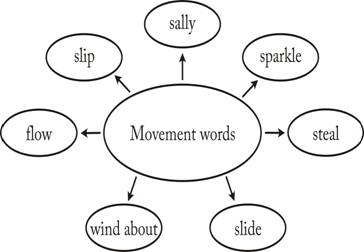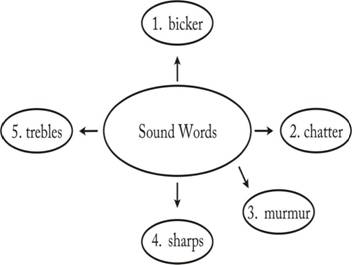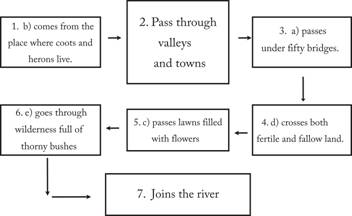Class 9 NCERT Solutions English Chapter P.1 - The Brook
The Brook Exercise 57
Solution 1
(a) Something that lives for one year annual
(b) Something that lives for about two years biennial
(c) Something that lives for more than two years perennial
Solution 2
Approximate details-
(a) a dog - 10 to 13 years
(b) an elephant- 60 to 70years
(c) a tree- Varies depending on the type .
(d) a human being- Average human life expectancy is from 65 to 84 years.
(e) a star- Over 50 billion years
(f) a mountain-No time span.
(g) a river-no time span- Till its source changes or it dries up.
Solution 3
The poem is about a brook. The brook itself is telling us its story about its origin. It narrates the sights it sees as it flows through valleys, forests, farms, open spaces till it reaches the main river.
The Brook Exercise 60
Solution 4a

Solution 4b

Solution 4c
Chatter, bicker, bubble.
The Brook Exercise 61
Solution 5

Solution 6a
(iii) eternal
Solution 6b
(i) the life of a man
Solution 6c
(i) Personification
Solution 6d
(i) the brook is a source of life.
The Brook Exercise 62
Solution 7a
The brook sparkles because of the sun's rays reflected on its water. The brook suddenly emerging and shining between the fern can also lend a shimmering quality to it.
Solution 7b
To bicker means to 'quarrel' or a 'noisy argument'.
The poet uses the word 'bicker' because the different sounds made by the brook as it flows along the various terrains. It resembles the sounds people make while noisily quarrelling with each other
Solution 7c
The brook passes thirty hills and fifty (half a hundred) bridges during its journey.
Solution 7d
The brook flows down the hills, through the ridges, past the towns, under the bridge and through the Phillips farm. It is here that the brook finally meets the river
Solution 7e
The word 'chatter' is repeated because it represents the continuous chattering sound made by the water of the brook as it flows. It is as if the brook is chattering along and telling us about its journey
Solution 7f
To fret means to 'fuss' or to worry'.
The brook never flows in a straight line; its course is full of twists and turns... It forms so many curves that it seems as if it is constantly 'worrying' its banks by changing its shape. This is what the poet means by the statement 'With many a curve my banks I fret'.
Solution 7g
The brook does not flow in a straight line but veers and twists itself along its way.
'I wind about, and in and out' creates a picture of the flowing waters of the brook resembling a maze or a labyrinth.
Solution 7h
The different things found floating in the brook are blossoms, foamy flakes and fish like the trout and grayling.
Solution 7i
By using the words 'steal' and 'slide', the poet wants to convey the fact that the brook can sometimes flow quietly. The term 'steal' is used to convey the stealthy movement of the river. The word 'slide' creates a mental picture of the river sliding along its path with the smooth movements of a snake. The sound of its movement is undetectable.
Solution 7j
'Alliteration' is the repetition of the same letter or sound at the beginning of closely connected words.
Examples of alliteration in the poem are:
- I slip, I slide
- I gloom, I glance
- By twenty thorpes, a little town,
- Many a fairy foreland set
- With willow-weed golden gravel
- foamy flake
- skimming swallows
Solution 7k
The term 'netted sunbeam' refers to the sun's rays that fall on the waters of the brook through the leaves. The sunbeams breaking through the foliage gives an impression of a net of light. The light that is thus reflected in all directions gives one the impression that the rays are dancing.
Solution 7l
The refrain in this poem is
"for men may come and men may go,
But I go on forever."
A refrain is a line or verse repeated at intervals through either a song or a poem most often at the end of each stanza.
It is usually used to bring out the key note or central idea of the poem.
In this poem, the refrain helps to highlight the idea that human life is transient. Man is mortal; they have a short span of life. But nature is immortal and can outlive man. That is why the brook, which is an element of nature, says it will go on forever.
Solution 8
a) In the given lines 'I' refers to the brook.
b) Chatter is a raucous sound of people talking. As the brook flows briskly over the rocks and pebbles it make a continuous sound like it is 'chattering'.
c) The word brimming means to be filled with so much water that it overflows.
The picture created is of the brook adding its water to the already full river and hence the river is overflowing .The volume of the river is immense and water is in abundance.
d) These lines tell us that men have a short span of life; man is mortal and human life is transient. The life of the brook, however, is continuous and will never end. Nature is immortal and can outlive man. That is why the brook says it will go on forever.
The immortal nature of the brook is contrasted with the fleeting nature of man's life.
Solution 9
Rhyming scheme is a definite pattern of rhyme between the lines of a poem or song.
Hern (a) ,sally (b),fern(a) ,valley(b)-alternate rhyming scheme.
The rhyming scheme of the poem is abab, cdcd, efef, ghgh.
Solution 10
A blossom sailing- A flower floating on the water is compared to a boat sailing on the ocean.
I chatter over stony ways, In little sharps and trebles- The sound that the moving water is compared to the chatter of people. It is almost musical to the ears as it consists of high and low sounds like the sharps and trebles of music notes.
Solution 11
In the poem 'The Brook' the poet has very realistically drawn a parallelism between the journey of the brook and the life of man.
When the brook begins its journey from its source, it emerges suddenly (sally) and flows with a lot of noise (bickers) and speeds down the valley. It hurries down the hills and slips down the ridges to reach its destination.
Similarly in man's youth he is very active and agile.
It continues to move quickly in its early stages in spite of all the stones, pebbles and other obstacles that come in its way. Similarly, man in his youth is very energetic and is able to face all the challenges and obstacles with great gusto.
The hazel covers and forget-me-nots that the brook flows by, stand for the joys one experiences in life.
As the brook passes the bramble bushes in the wild, it murmurs (complains). Similarly in life, when one meets with sorrows and dangers, we too complain and move slowly past them.
As the brook comes closer to the river it slows down. It steals, slides, slips, lingers and loiters. This is similar to man at the age of maturity-in his old age. His movements slow down and he becomes calm and less energetic.
The Brook Exercise 63
Solution 12
Students are recommended to use their creativity and answer this question independently.
Some guidelines:
Similes:
A figure of speech used to compare two unlike things. It is introduced by 'like' or 'as'.
Alliteration: The use of words that begin with the same sound near each other. repetition of the initial consonant-babbling brook/field and fallow.
Metaphor: It is an implied simile.

